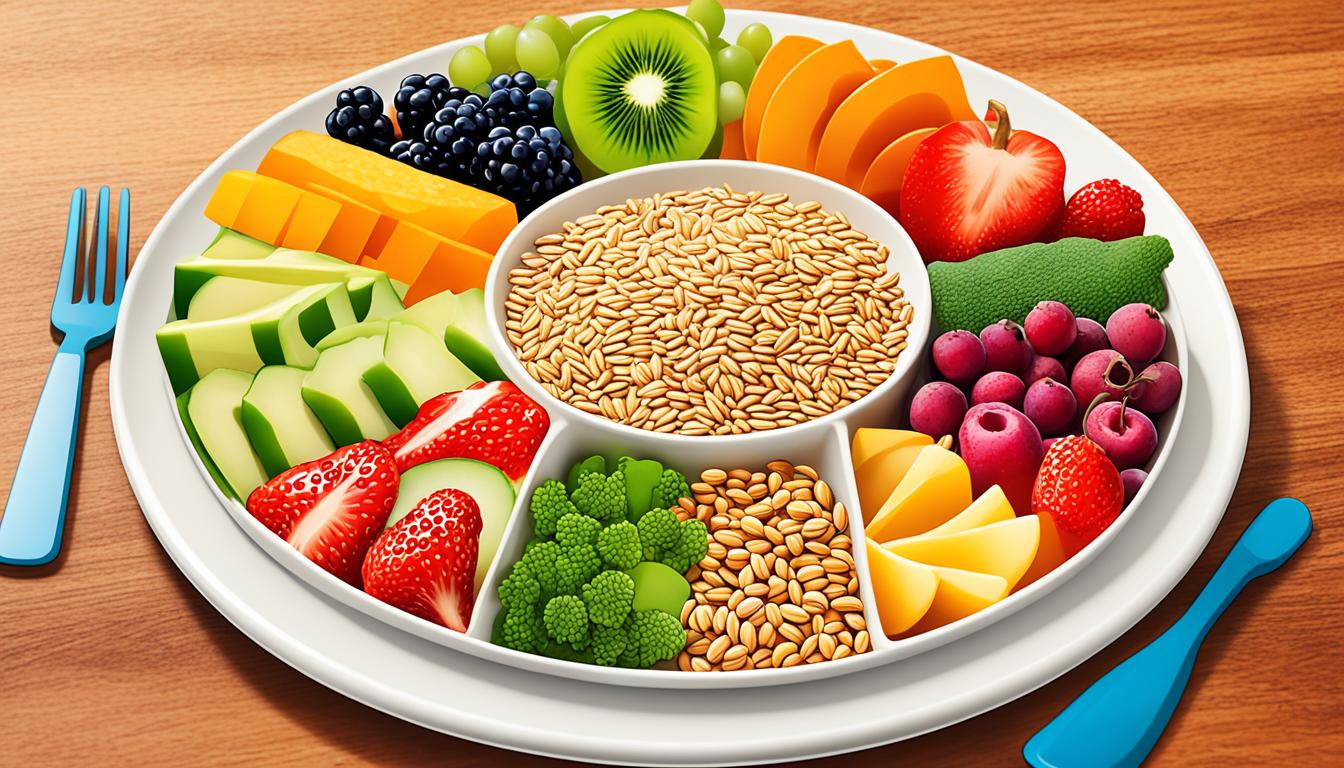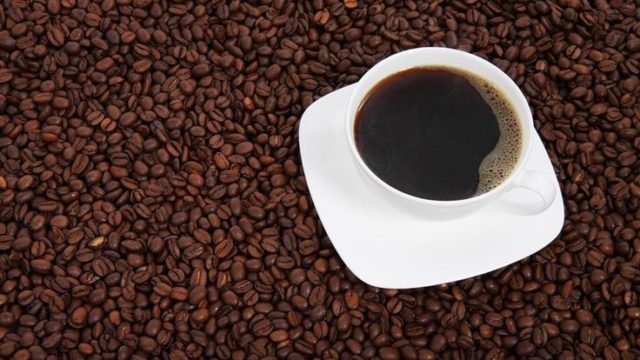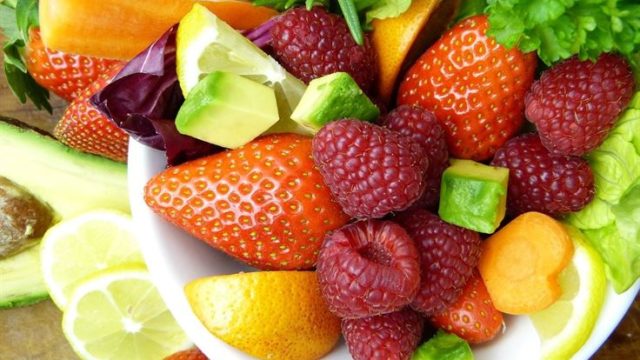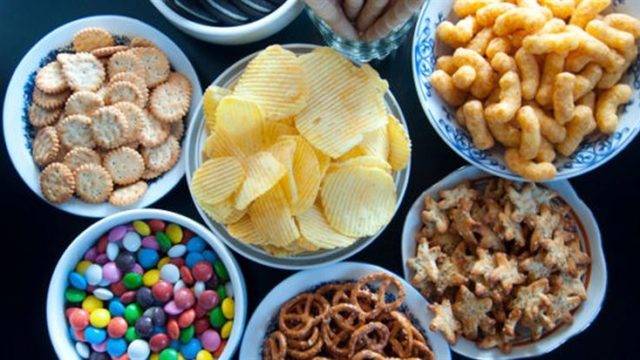FTC disclaimer: This post may contains affiliate links and we will be compensated if you click on a link and make a purchase.
Only 5 percent of Americans meet their daily fiber requirements. This shows a big difference between what’s suggested and what people actually eat. Fiber is very important in our diet. It helps us stay healthy, keeps our weight in check, and lowers the chances of getting sick. So, how much fiber should you eat, and where can you find it? Let’s find out.
Key Takeaways
- The recommended daily fiber intake varies depending on age, sex, and caloric intake, with guidelines suggesting 14 grams per 1,000 calories for individuals aged 2 and older.
- Children between 12 months and 23 months should consume 19 grams of fiber per day.
- The average American’s daily fiber intake is only about 16 grams, significantly lower than the recommended amounts for optimal health.
- Fiber-rich diets have been linked to lower rates of heart disease and can aid in weight management by promoting a feeling of fullness.
- Gradually increasing fiber intake is recommended to prevent potential digestive issues such as gas, bloating, and diarrhea.
What is Fiber and Why is it Important?
Dietary fiber is a key nutrient for our health. It’s a type of carb our body can’t break down. This makes it great for keeping our digest system healthy. Fiber comes in two types, soluble and insoluble, each with their own good points.
Soluble and Insoluble Fiber
Soluble fiber mixes with water and is good for lowering cholesterol and blood sugar. You can find it in foods like apples, oranges, and some veggies. Plus, dry beans, lentils, and barley are good sources too.
Insoluble fiber, on the flip side, does not dissolve. It’s great for keeping you regular and avoiding constipation. You’ll get insoluble fiber from fruits with edible skins, whole grains, and products made of them.
Both types are vital for a healthy gut and can lower the risk of many diseases. They even help with managing your weight. Fiber makes you feel full and slows down sugar absorption. This is good for managing your blood sugar levels.
“Fiber can slow the absorption of sugar and help improve blood sugar levels, aiding in controlling blood sugar levels, especially for individuals with diabetes.”
Even with all its positives, most Americans don’t get enough fiber. Fiber, Only about 5% of American adults meet their daily fiber needs. On average, US adults get about 15 grams of fiber a day. This is only half of what’s recommended.
Adding more fiber-rich foods to your diet can really boost your health. It can have a big positive impact on how you feel and your health overall.
Recommended Daily Fiber Intake
The amount of fiber you need each day changes with your age and if you’re a man or woman. For adults eating a 2,000-calorie diet, the FDA advises getting 28 grams of fiber daily. Men and women under 50 should try to have 31-34 grams or 25-28 grams, respectively.
If you’re 51 or older, you should aim for 28 grams or 22 grams, again depending on your gender. Kids from 1 to 18 years old need 14-31 grams per day, depending on their age and if they’re a boy or girl.
The Academy of Nutrition and Dietetics says adults should try to get about 30 grams of fiber daily for the best health effects.
Age and Gender | Recommended Fiber Intake (grams per day) |
|---|---|
Children 1-3 years | 19 grams |
Children 4-8 years | 25 grams |
Girls 9-18 years | 26 grams |
Boys 9-13 years | 31 grams |
Boys 14-18 years | 38 grams |
Women 19-50 years | 25 grams |
Men 19-50 years | 38 grams |
Women 51+ years | 21 grams |
Men 51+ years | 31 grams |
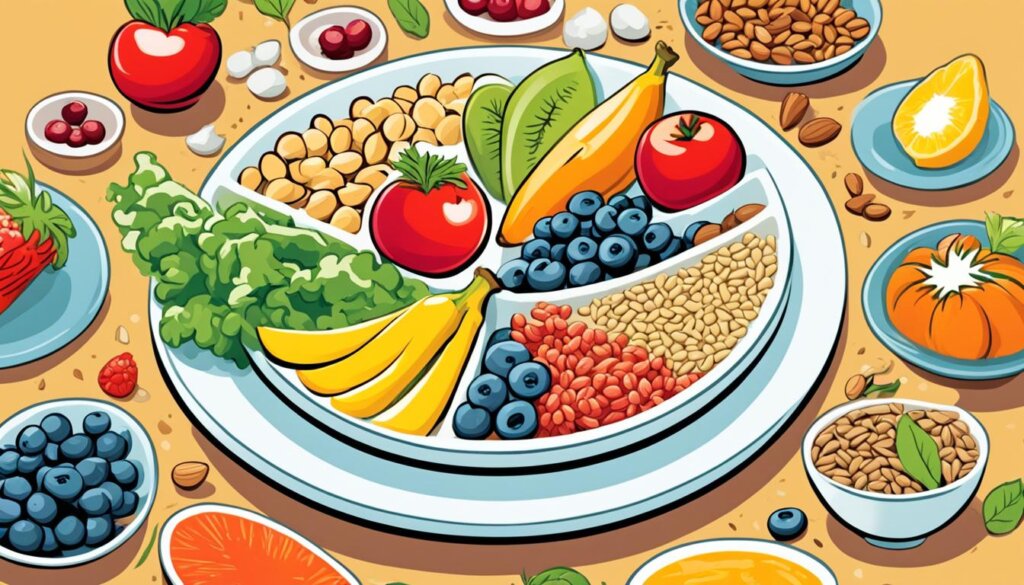
Knowing how much fiber to eat daily helps you stay healthy. Adding lots of fiber-rich foods to your meals and snacks is a good way to get enough fiber.
High-Fiber Food Sources
Adding high-fiber foods to your meals boosts your fiber intake. You can choose from many fruit, vegetable, and grain options that are rich in fiber.
Fruits and Vegetables
Raspberries, pears, apples, and oranges are top high-fiber fruits. For example, raspberries have about 8 grams of fiber in a cup. Pears and apples each offer 4-5 grams of fiber. Their skins have lots of fiber too.
In the veggie department, green peas, broccoli, Brussels sprouts, and sweet potatoes shine. Cooked peas have nearly 9 grams of fiber per cup. A sweet potato (eaten with its skin) gives over 4 grams of fiber.
High-Fiber Food | Fiber Content per Serving |
|---|---|
Pears | 3.1 grams per 100 grams |
Strawberries | 2 grams per 100 grams |
Avocado | 6.7 grams per 100 grams |
Oats | 10.1 grams per 100 grams |
Apples | 2.4 grams per 100 grams |
Lentils | 10.7 grams per 100 grams |
Kidney Beans | 7.4 grams per 100 grams |
Popcorn | 14.5 grams per 100 grams |
Almonds | 13.3 grams per 100 grams |
Fruits and veggies vary in their fiber content, but many are rich in fiber. Eating a wide range of these foods is great for getting more fiber.
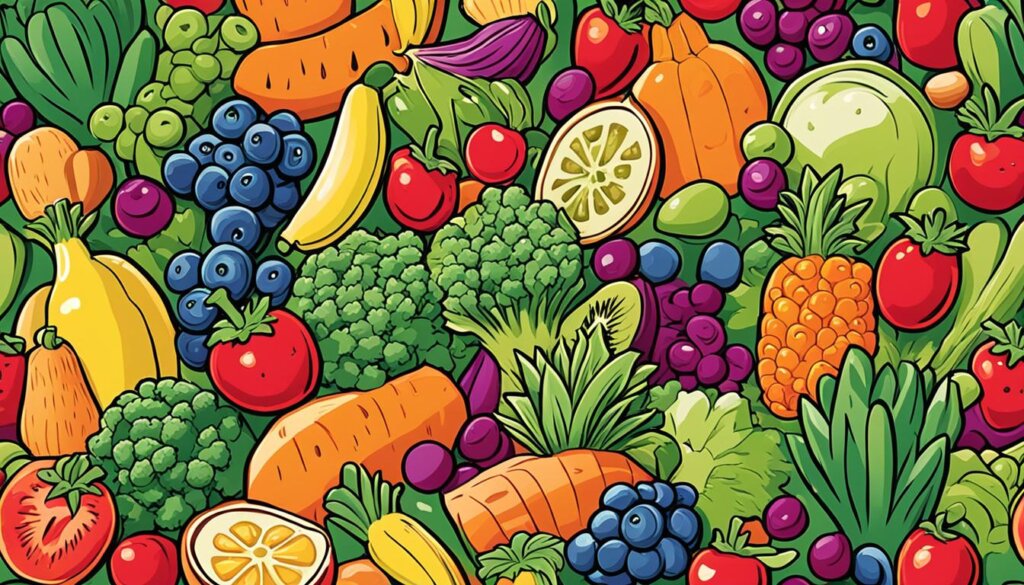
Don’t forget about grains like barley, oats, and quinoa. They’re also fiber-packed. Oatmeal has more than 4 grams of fiber in a cup. Quinoa gives about 5 grams in each serving.
Making sure to eat a mix of high-fiber foods will up your fiber game easily.
“Eating a diet rich in fiber from fruits, vegetables, whole grains, and legumes is one of the best ways to improve your health and reduce your risk of chronic diseases.”
How Much Fiber Per Day?
Getting enough daily fiber intake is key for your health. Your fiber requirements are different depending on your age and if you’re a man or woman. Adults need 25 to 35 grams (0.8 oz to 1.2 oz) of fiber each day, says the American Academy of Nutrition and Dietetics.
At age 70, women should eat 21 grams (0.7 oz) a day, and men need 30 grams. Adding 8 more grams (0.2 oz) of fiber daily can cut the risk of heart disease and cancer by 5 to 27 percent. Also, those who eat the most fiber see a 23 percent lower risk of death than those who eat very little.
Beans, peas, and chia seeds are the top sources of fiber per cup. Having 14 grams of soluble fiber per 1,000 calories is best for your health.
Despite clear guidelines, the average American eats only about 16 grams of fiber per day. This is less than what’s needed. Adding more raspberries, green beans, and whole wheat spaghetti to your meals can get you closer to the goal.
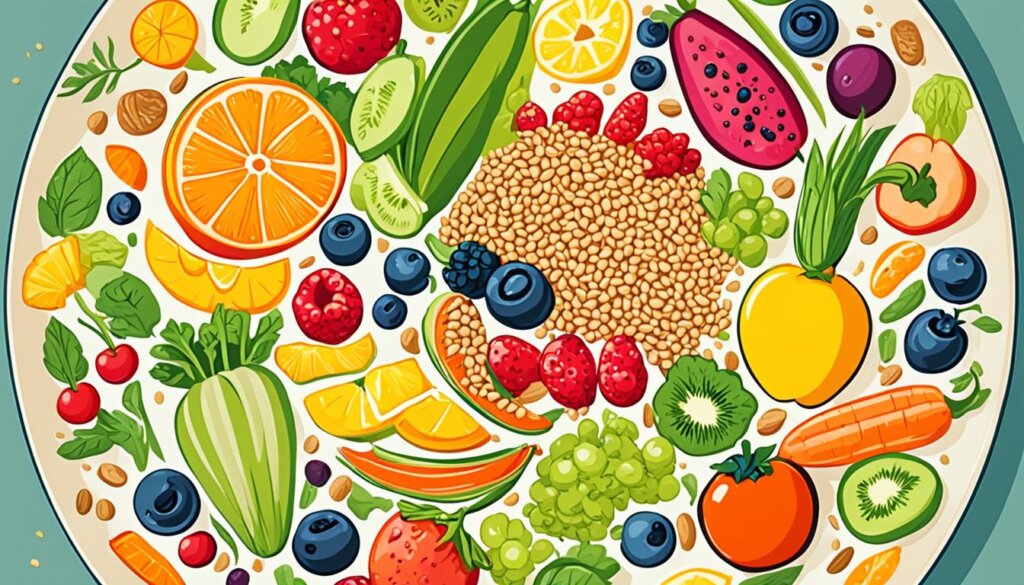
Being part of a weight loss effort that tracks fiber intake can mean fewer issues like constipation and tiredness.
To sum up, adults should get 25 to 35 grams of fiber daily. Adding fiber-rich foods into your diet brings many health benefits. It also helps you reach the fiber intake guidelines.
“Fiber is essential for overall health, and most Americans fall short of the recommended daily intake. Increasing your fiber intake can have a significant impact on your well-being.”
– Nutrition expert, Jane Doe
Benefits of a High-Fiber Diet
Eating enough fiber helps us in many ways. It makes us feel full, aiding in weight loss. Fiber reduces bad cholesterol and blood sugar levels, lessening chances of heart problems, stroke, and diabetes. It improves our digestion and can make our risks of some cancers lower. Fiber is also key for keeping our gut healthy.
Yet, most Americans don’t get enough fiber. Only a small part meet the daily goal. This goal changes based on your age and sex. For example, women under 50 should aim for 25 grams a day.
Adding more fiber-rich foods to your diet is crucial. Good choices include fruits, veggies, whole grains, and legumes. Eats like unsweetened fiber cereals, navy beans, and bran flakes can boost your fiber intake. Mixing in these foods during meals, such as fruit and cereal for breakfast, can help you reach the target.
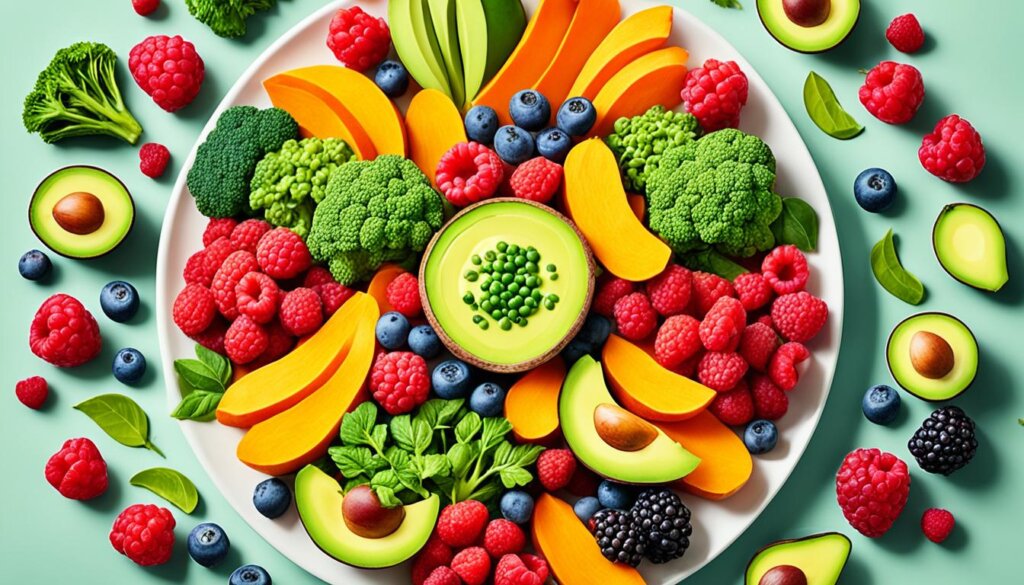
Fiber supplements can help, but real foods are better. It’s good to ramp up your fiber gradually, while drinking enough water. This is best for your gut and your entire health. Yet, some people, especially with certain health issues, might need a doctor’s advice on fiber intake.
“Eating a diet high in fiber can provide numerous health benefits, from supporting weight loss to reducing the risk of chronic diseases like heart disease and cancer.”
Adding more fiber to your diet can be simple. Swapping in fiber-rich foods can boost your health. With a few meal changes, you can hit your daily fiber target.
Increasing Your Fiber Intake
Simple Tips
Adding more fiber to your diet is easy. Start by eating whole fruits and vegetables instead of juices. Juices often lack fiber. You should also eat whole grains like brown rice instead of white.
Eating nuts, seeds, and beans helps too. Try chia or flax seeds. They’re full of soluble fiber that’s good for your gut. Add high-fiber foods to your diet slowly. Doing it too fast could upset your stomach.
Don’t forget to drink lots of water when you add more fiber to your meals. Fiber soaks up water. Keeping hydrated helps stop constipation and other tummy troubles. Making small changes in what you eat can make it easier to get enough fiber each day.
Fiber Supplements and Precautions
Fiber supplements are useful for some, but eating whole foods is often better. A high-fiber diet suggests 25 to 30 grams daily. For reference, Methylcellulose in Citrucel offers 2 grams per tablespoon, while Psyllium in Konsyl has 6 grams per teaspoon.
Too much fiber might cause issues like gas, bloating, and stomach pain. People with diabetes should avoid sugary supplements, and those on Coumadin should shun psyllium. Always talk to a doctor if you suffer badly after increasing your fiber.
When selecting a fiber supplement, know your options and their needs. FiberCon Caplets contain 500 mg of polycarbophil each, meant to take 1 to 4 daily. Hydrocil Instant gives 3.5 grams of psyllium per teaspoon, and Perdiem has 4 grams per teaspoon. UniFiber has 3 grams of cellulose per tablespoon.
The facts about fiber supplements here are to learn from, not to replace doctor advice. Go slow and steady when upping your fiber to prevent stomach upsets.
Fiber Supplement | Fiber Content per Serving | Recommended Dosage |
|---|---|---|
FiberCon Caplets | 500 mg of polycarbophil per caplet | 1 to 4 caplets per day |
Hydrocil Instant | 3.5 grams of psyllium per teaspoon | – |
Perdiem | 4 grams of psyllium per teaspoon | – |
UniFiber | 3 grams of cellulose per tablespoon | – |
“Fiber supplements can help lower cholesterol and blood sugar, ensure regular bowel movements, treat constipation, and reduce the risk of heart disease and colon cancer.”
Yet, fiber supplements need care because they could cause issues if overdone. Always chat with a doctor first, especially with certain health conditions or if you’re taking other drugs.
Soluble Fiber and Its Benefits
Soluble fiber is a kind of fiber that mixes with water in your belly. It’s really good for you. It can help lower bad cholesterol, keep your blood sugar steady, and make you feel full, which is great for your weight. You can find it in oats, beans, and even in apples and carrots.
Eating enough fiber can keep diseases away. Soluble fiber helps a lot in your stomach. It turns into special fatty acids that can make you less hungry. Adding more fiber to your meals is super healthy. These fatty acids are very important for your body’s health.
But sadly, most Americans don’t eat enough fiber. Only a small number eat the right amount, which is about 30 grams. People with less money often don’t eat enough fiber, showing money can affect what we eat.
To get more soluble fiber, eat lots of foods like oats and beans. The government says how much fiber people should eat each day, depending on their age and if they are male or female. For women and men in their twenties, it’s about 28 to 34 grams. If you’re 51 or older, you need a bit less.
While soluble fiber is really good for you, don’t have too much. Too much can make you bloated or feel gassy. People with some stomach issues might find it hard to eat too much fiber. To make your stomach happy, eat foods like apples and oats, bananas, and dark chocolate.
Soluble Fiber Content in Common Foods | Grams per Serving |
|---|---|
Oats (1 cup cooked) | 4 |
Beans (1 cup cooked) | 4-7 |
Lentils (1 cup cooked) | 6 |
Apple (1 medium) | 4 |
Orange (1 medium) | 3 |
Carrot (1 cup raw) | 3 |
Eating a variety of foods rich in soluble fiber is great for your health. You get better heart and blood sugar health, manage your weight better, and keep your stomach happy.
Conclusion
Dietary fiber is super important for our health. How much we need depends on our age and if we’re male or female. On average, adults should aim for 22-34 grams each day. You can find fiber in many foods like fruits, veggies, whole grains, nuts, seeds, and legumes.
They help keep our digestive system healthy, help us manage our weight, and prevent diseases. While some find fiber supplements useful, it’s better to focus on eating more fiber-rich foods. That way, you get more benefits from a natural source.
Making fiber a regular part of your diet means you’ll be healthier and happier. It’s key to keeping your body in good shape and avoiding a lot of health problems. Add plenty of fiber-rich foods to what you eat every day. This is a great move for your health because you’ll get more of the benefits that fiber offers.
The key takeaways are simple: aim for the daily fiber amount, pick whole foods for fiber, and regularly eat high-fiber foods. This advice will lead you to a path of better health and life.
FAQ
What is dietary fiber and why is it important?
Dietary fiber is from plants and can’t be broken down by our bodies. It’s great for our gut and helps lower bad cholesterol. There are two types: soluble and insoluble. Both are good for you.
What are the recommended daily fiber intake levels?
Everyone needs a different amount of fiber every day. For adults, aim for around 28 grams. Yet, this changes with age and if you’re a man or a woman. Kids should get between 14 to 31 grams daily.
What are some of the best high-fiber food sources?
You can find fiber in many tasty foods. Eat fruits, vegetables, legumes, whole grains, and nuts. Try raspberries, pears, green peas, and quinoa. They are all rich in fiber.
What are the benefits of consuming an adequate amount of dietary fiber?
Eating enough fiber has a lot of perks. It can help with losing weight and make you feel full. It’s also good for your heart, lowers diabetes risk, and aids digestion. Plus, it feeds your good gut bacteria.
How can I easily increase my daily fiber intake?
Boosting your fiber is pretty simple. Eat whole fruits and veggies, choose whole grains, and snack on nuts and seeds. Don’t forget to drink plenty of water. Slowly add these to your meals to avoid stomach problems.
Are there any precautions or downsides to consuming too much fiber?
While fiber is good for you, too much can cause issues. It might lead to problems like gas or diarrhea. If you feel really bad, talk to a doctor.
What are the benefits of soluble fiber specifically?
Soluble fiber helps with heart health and blood sugar. It also makes you feel full, which can help with weight. Oats, beans, apples, and carrots are top sources.
